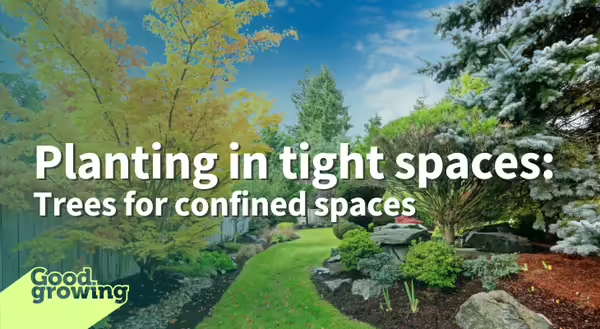
Trees are an essential element of a healthy, vibrant community. Trees, large and small, help clean our air, shade our landscapes, provide wildlife habitat, and improve our mental and physical well-being. Planting trees throughout our community, in parks, along streets and trails, at civic buildings, and in residential yards is ideal, but these locations often have limited available space for large plants.
Small spaces look different throughout the community. They include residential lots with limited yard space, but also include boulevard spaces where pavement and utilities restrict planting space, empty lots in downtowns where adjacent buildings interfere with growth potential, park spaces that need to accommodate other uses from time to time (occasional parking, festivals, spectators, etc.). Although these spaces seem like they would not be conducive for tree planting, with thoughtful planning and species selection, many small landscape spaces can be home to trees.
Challenges of trees in small landscapes
When landscaping any site, it is important to identify the limitations of the site so decisions can be made taking the limits into consideration. Additionally, large trees in small space can negatively impact the use and enjoyment of the site.
- Above-ground space is easy to observe and assess, but below-ground space for plant growth, the area that will accommodate root growth, should not be overlooked. Plant health and longevity can be negatively impacted if the root zone is inadequate.
- A large tree in a small space can dominate a space and outcompete other plants for water, nutrients, and light.
- Large trees in a small space can overwhelm the senses and create an atmosphere that feels claustrophobic.
- With time, the growth of roots or branches can encroach on built infrastructure and cause damage.
Benefits of trees in small landscapes
Although special considerations are required when choosing to incorporate a tree into a small site, the benefits may far outweigh the limitations.
- Trees add structure and height to a landscape, creating visual appeal and interest.
- Trees improve air quality, provide habitat for wildlife, absorb stormwater, and cast shade that helps cool our landscape.
- Many small to medium-sized trees offer multi-season appeal, producing abundant blooms in the spring, colorful fall foliage, and ornamental fruit.
- In some landscapes, smaller trees can create a sense of enclosure and privacy.
Planting considerations
To maximize the potential of trees in compact landscapes, consider the following recommendations.
- Choose species with sizes and growth habits that align with site conditions. Look to varieties that offer more variety than straight species. Look for species that are dwarf or have a columnar growth habit, these traits help accommodate tight landscape spaces.
- Locate trees away from structures, utilities, and other plants that may result in interference as the trees grow. Although the species or variety being planted is smaller in size, trees will still grow. The overall mature size of the tree needs to be accommodated.
- Ensure the site soil can support healthy root development. Take measures to remedy compaction and poor composition prior to planting.
- Plan for maintenance during and after establishment. Plan for regular pruning, watering, and protection as necessary to ensure healthy growth.
Species to consider
Although small sites are limiting, numerous tree species are available for consideration in Illinois. The following list is a starting point. For more information or recommendations, contact your local Illinois Extension office to talk to someone.
- Eastern Redbud (Cercis canadensis)
- Serviceberry (Amelanchier spp.)
- Pagoda Dogwood (Cornus alternifolia)
- Japanese Tree Lilac (Syringa reticulata)
- Red Buckeye (Aesculus pavia)
- Hawthorn (Crataegus spp.)
Incorporating trees in the landscape possesses the potential to return a myriad of benefits to the landowner and the community. Regardless of the size of the site, benefits can be optimized through careful species selection and long-term care. No matter the size of the site, consider incorporating trees into the landscape and take advantage of the visual appeal, environmental benefits, and seasonal beauty they provide.
Good Growing Fact of the Week: If you have a tree in your landscape that needs the care of a professional arborist, search for one in your area by visiting www.TreesAreGood.org, hosted by the International Society of Arboriculture.
Thank you for reading!
Sign up for our emails! Want to get notified when new Good Growing posts are available? SIGN ME UP
Give us feedback! How helpful was this information (click one): Very helpful | Somewhat helpful | Not very helpful
MEET THE AUTHOR
Emily Swihart is a horticulture educator with University of Illinois Extension, serving Henry, Mercer, Rock Island, and Stark counties since 2021. Emily provides horticulture programming with an emphasis on the home gardener, the urban forest, native plant ecosystems, and landscape design. Additional responsibilities include supporting local county Master Gardener and Master Naturalist volunteers - providing training, continuing education, advanced training, and their involvement in seasonal events and community outreach programs.